
What is a Micro Hydro Power Plant? It's a small, as the name says, "micro" power plant which produces electricity through a water stream. It produces 1 kW to 20 kW power, providing 4 to 100 houses with enough electricity for light only. Each house can install about 3 bulbs of 40 to 60 Watt power. The cost per household depends of course very much on the remoteness of the area installed and the material used. But for Humla we can say that the total cost per house for a micro hydro power plant for light is around 30'000 NRs (approx. 400 US$). This is a rough average of the last few installed micro hydro power plants in the Humla region.
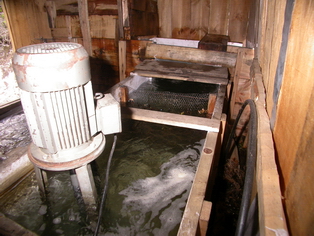
As the Humli people belong to the three poorest communities in Nepal, which is itself among the poorest three countries in the world, we have to be aware that we are working together with the most disadvantaged people groups in the world. Here the word "appropriate technology" becomes a real challenge. Technology which is affordable by the local people and can be maintained by the local people is demanded here. Without intensive research, development and especially a love for the people one will hardly come close to a satisfactory result for an "appropriate technology" solution.
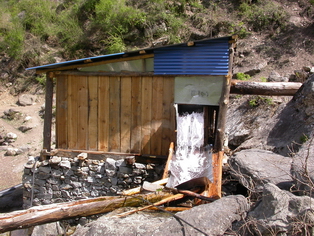 With the call to serve these disadvantaged people groups in Humla, RIDS-Nepal wants to participate in the grass root research and development of appropriate technical solutions. Especial attention is given in the production of electricity for light, as smoke in the houses from the burning of "Jharro", the smoky pine wood raisin people burn for light, is one of the major reasons for the wide spread lung and chest diseases, people suffer severely under in Humla. With the call to serve these disadvantaged people groups in Humla, RIDS-Nepal wants to participate in the grass root research and development of appropriate technical solutions. Especial attention is given in the production of electricity for light, as smoke in the houses from the burning of "Jharro", the smoky pine wood raisin people burn for light, is one of the major reasons for the wide spread lung and chest diseases, people suffer severely under in Humla.
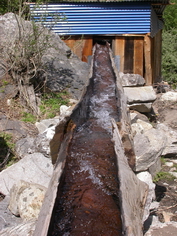 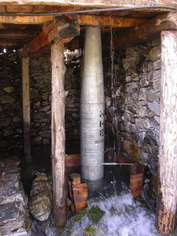 What does "Pico Hydro Power" exactly mean? "Pico" means " very very small", thus speaking of an electricity power production of 200 Watt to 5 kW through a water stream. But how many houses can you provide with light with such a small power? Not many if you use traditional light bulbs. That's why we talk about research, development, love and dedication for appropriate and affordable solutions. The Pico Power Plant is small, uses ready available parts and thus is comparably cheap. Transport, installation and maintenance costs are low and the technologies used simple. This all makes it far more appropriate for undeveloped and remote areas such as Humla. That's in short "one side of the coin", the electricity production. What does "Pico Hydro Power" exactly mean? "Pico" means " very very small", thus speaking of an electricity power production of 200 Watt to 5 kW through a water stream. But how many houses can you provide with light with such a small power? Not many if you use traditional light bulbs. That's why we talk about research, development, love and dedication for appropriate and affordable solutions. The Pico Power Plant is small, uses ready available parts and thus is comparably cheap. Transport, installation and maintenance costs are low and the technologies used simple. This all makes it far more appropriate for undeveloped and remote areas such as Humla. That's in short "one side of the coin", the electricity production.
 The "other side of the coin" are the lights. With so little power we have to have very low power consuming lights, in order to provide many houses with light, so that the cost per household drops. In conjunction with the University of Calgary in Canada RIDS-Nepal produced the first WLED (White Light Emission Diodes) lights. LEDs are not a very new technology, they have been around since many years (you find them in your PC, radio, stereo etc.). But the white LEDs are rather new, only since about the mid 90's has this technology been developed. The LEDs are known to consume very little power, 0.1 Watt and less per piece (there are different varieties). The same is applicable for the white LEDs, the WLEDs. Thus a light (as pictured) with a cluster of 9 WLEDs consumes just 0.8 Watt. Thus how many lights can be provided by a 150 Watt Pico Power Plant? The "other side of the coin" are the lights. With so little power we have to have very low power consuming lights, in order to provide many houses with light, so that the cost per household drops. In conjunction with the University of Calgary in Canada RIDS-Nepal produced the first WLED (White Light Emission Diodes) lights. LEDs are not a very new technology, they have been around since many years (you find them in your PC, radio, stereo etc.). But the white LEDs are rather new, only since about the mid 90's has this technology been developed. The LEDs are known to consume very little power, 0.1 Watt and less per piece (there are different varieties). The same is applicable for the white LEDs, the WLEDs. Thus a light (as pictured) with a cluster of 9 WLEDs consumes just 0.8 Watt. Thus how many lights can be provided by a 150 Watt Pico Power Plant?
 In December 2006, RIDS-Nepal installed the first Pico Power Plant prototype made by NHE (Nepal Hydro Electric) in Butwal, producing 650 Watt power by a water flow of 27 liter per second and a negative head of 5 meter ("negative" because the "head" is not "in front" of the turbine providing pressure, but after the turbine producing a vacuum through a conical shaft, and thus "sucking" the water through the turbine). Another challenge was to install the Pico without any cement, as in a place like Humla where all materials have to be carried in for 15 days from the next road head, or flown in by plane, material becomes unaffordable expensive for the local people. Thus as much as possible only local material, which means stone, wood and mud can be used for the dam, the canal and the power house. In December 2006, RIDS-Nepal installed the first Pico Power Plant prototype made by NHE (Nepal Hydro Electric) in Butwal, producing 650 Watt power by a water flow of 27 liter per second and a negative head of 5 meter ("negative" because the "head" is not "in front" of the turbine providing pressure, but after the turbine producing a vacuum through a conical shaft, and thus "sucking" the water through the turbine). Another challenge was to install the Pico without any cement, as in a place like Humla where all materials have to be carried in for 15 days from the next road head, or flown in by plane, material becomes unaffordable expensive for the local people. Thus as much as possible only local material, which means stone, wood and mud can be used for the dam, the canal and the power house.
  RIDS-Nepal installed the Plant in Kholsi village (30°00'25.77" North / Longitude: 81°45.24.00" East / Altitude: 2515 meter above sea level, 745 mbar pressure at 20°C). Kholsi has a good hydro resource with a river flowing just north-west of the village. Hydropower being the most sustainable and locally available renewable resource, the pico-hydro plant was installed at the river which is about 700m from the village in North East direction. RIDS-Nepal installed the Plant in Kholsi village (30°00'25.77" North / Longitude: 81°45.24.00" East / Altitude: 2515 meter above sea level, 745 mbar pressure at 20°C). Kholsi has a good hydro resource with a river flowing just north-west of the village. Hydropower being the most sustainable and locally available renewable resource, the pico-hydro plant was installed at the river which is about 700m from the village in North East direction.
 From June 2000, RIDS-Nepal begin to made WLEDs lights, which RIDS-Nepal got sponsored from the Calgary University in Canada. A survey and estimation was done for 67 houses in Kholsi, two to three lights of 9 WLEDs per household, total 200 lights. A total power consumption of 650 Watt. Due to the enormous deforestation problems in Humla, RIDS-Nepal puts all wires underground. That helps save the soft pine wood, the wires are also much better protected from the monsoon rains, the snow in the winter and the storms in spring time. It is more costly initially, but that pays off quickly, as there is hardly any maintenance needed for years to come. As a Pico produces just 650 Watt by 220 Volt AC, we have just 4.5 Amps flowing through the wires.After 1 years running, the Pico was providing non stop light, very few minor brake downs in the underground wire occurred which we all could handle and repair in Humla. From June 2000, RIDS-Nepal begin to made WLEDs lights, which RIDS-Nepal got sponsored from the Calgary University in Canada. A survey and estimation was done for 67 houses in Kholsi, two to three lights of 9 WLEDs per household, total 200 lights. A total power consumption of 650 Watt. Due to the enormous deforestation problems in Humla, RIDS-Nepal puts all wires underground. That helps save the soft pine wood, the wires are also much better protected from the monsoon rains, the snow in the winter and the storms in spring time. It is more costly initially, but that pays off quickly, as there is hardly any maintenance needed for years to come. As a Pico produces just 650 Watt by 220 Volt AC, we have just 4.5 Amps flowing through the wires.After 1 years running, the Pico was providing non stop light, very few minor brake downs in the underground wire occurred which we all could handle and repair in Humla.
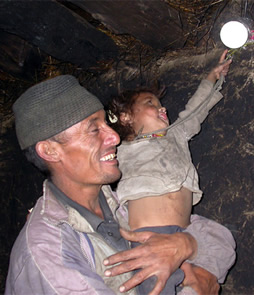 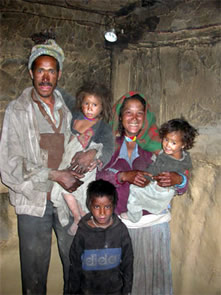 The people from the 67 households in Kholsi provided all the local material such as the wood for the canal and the power house, the stones and the mud for the dam, as well as all the labor for the digging of the canals for the wires voluntarily. Thus since December 2006, 67 houses in Kholsi village have WLED lights providing basic light in their houses. It is not as bright in the rooms as with a 40 Watt bulb, but enough to discuss with each other and see the others reaction, to cook and to read. And, what is best, instead of one 40 Watt bulb, there can now burn over 20 WLED lights. What are the actual costs per household with a Pico Power plant and WLEDs? If a project is in the research and development stage, real costs are always difficult to extract. But calculating all the material, such as the Pico Power Plant, the wires, the HDP pipes, the switches, the WLEDs, the transport costs, etc. the cost for one household is around 5000 NRs, or 60 US$. Now we need to compare that to the previous micro hydro power plant cost per household, which was around 30'000 NRs (approx. 400 US$). Thus the Pico and the WLED cost approx. 6 times less. Does that seem to be an appropriate way into the future? The people from the 67 households in Kholsi provided all the local material such as the wood for the canal and the power house, the stones and the mud for the dam, as well as all the labor for the digging of the canals for the wires voluntarily. Thus since December 2006, 67 houses in Kholsi village have WLED lights providing basic light in their houses. It is not as bright in the rooms as with a 40 Watt bulb, but enough to discuss with each other and see the others reaction, to cook and to read. And, what is best, instead of one 40 Watt bulb, there can now burn over 20 WLED lights. What are the actual costs per household with a Pico Power plant and WLEDs? If a project is in the research and development stage, real costs are always difficult to extract. But calculating all the material, such as the Pico Power Plant, the wires, the HDP pipes, the switches, the WLEDs, the transport costs, etc. the cost for one household is around 5000 NRs, or 60 US$. Now we need to compare that to the previous micro hydro power plant cost per household, which was around 30'000 NRs (approx. 400 US$). Thus the Pico and the WLED cost approx. 6 times less. Does that seem to be an appropriate way into the future?
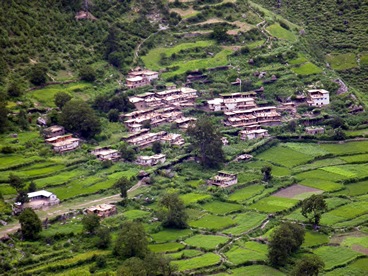 And the people are happy, as they never ever had light in their homes. There is hardly a day gone by since Decemeber 2006, when not a person came to the RIDS-Nepal office in Simikot to ask when the next upgrading will begin in Kholsi Village. See the picture, this is Khols Village, with the Pico hydro providing 650 Watt power with 67 house hold. Are you excited ? Do you want to be part of it ? Do you want some more information how to participate in this upgrade ? Please do get in contact with us. Our email: azahnd@rids-nepal.org And the people are happy, as they never ever had light in their homes. There is hardly a day gone by since Decemeber 2006, when not a person came to the RIDS-Nepal office in Simikot to ask when the next upgrading will begin in Kholsi Village. See the picture, this is Khols Village, with the Pico hydro providing 650 Watt power with 67 house hold. Are you excited ? Do you want to be part of it ? Do you want some more information how to participate in this upgrade ? Please do get in contact with us. Our email: azahnd@rids-nepal.org
|





